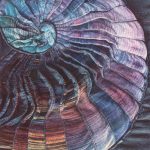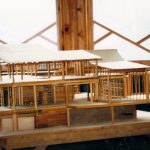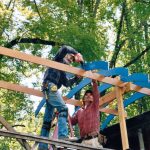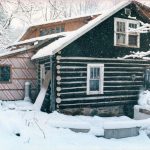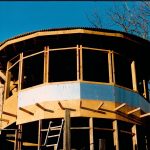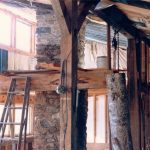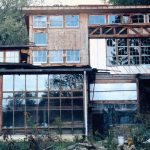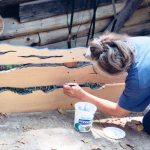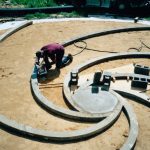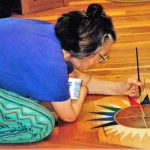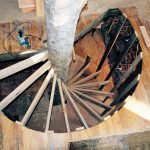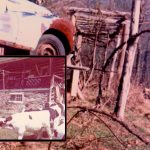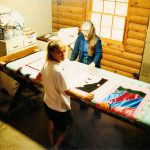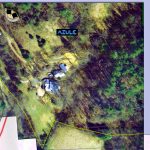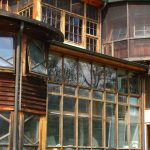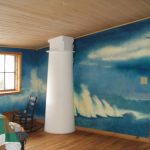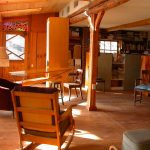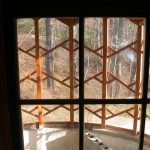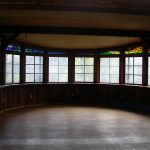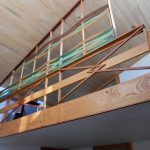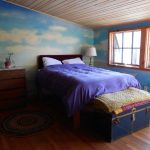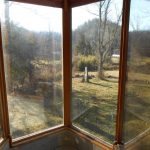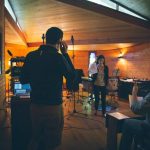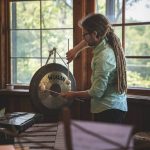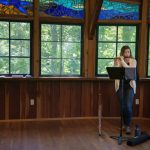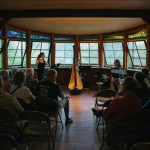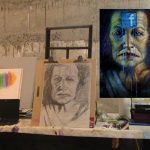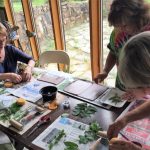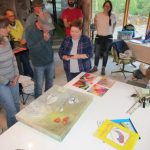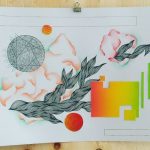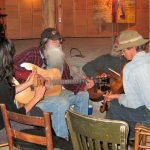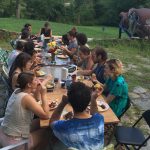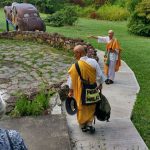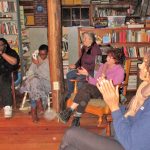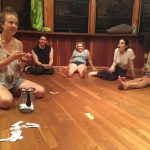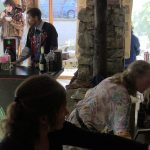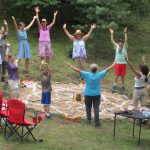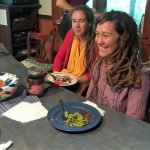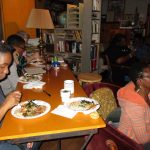Azule contains myriad mosaics, all of them painstakingly designed and executed by Camille. Photo: Azule Archives. This article is part of the Creating Place project. View the full multimedia collection here.
Article & Photo Collages by Alicia Arraya | April 25, 2018
Without cultural and deeply creative efforts, addressing the many woes that face human life seems at best difficult and problematic. In relation to such healing processes, developing spaces where creativity gestates – creative placemaking – may be a key component of our continued viability. In this regard, Azule, A Place for the Arts & Community, in Hot Springs, North Carolina, represents a community-based expression of these innovative developments. In its forty years of operation Azule has evolved through identifiable phases toward a fuller, richer, more authentic manifestation of what creative placemaking stands for as a transformative social possibility.
The first phase began over seventy years ago in France, where a little Normandy girl lost her arm to a bomb, and continued with her growing to womanhood to marry a stalwart American worker with whom she sought a sinecure for art and self-sufficiency in Southern Appalachia. Her early trauma aided her development as an artist, for her earliest conceptions of her homeland are those of a lovely fertile countryside reduced to rubble – little pieces that must be put together again. Camille’s devotion to quilting, mosaic arts, and other piecemeal techniques speak to this. “Maybe this is my aesthetic,” Camille has stated, “to rebuild, reassemble what has been exploded.” After the couple moved to the mountains, they both maintained this vision of creating – through thrift, ingenuity, and vision – something magnificent out of whatever they could find. The home itself has been built a bit like a mosaic, piece-by-piece, each decade or era unfolding a new floor, or corridor, or amenity.
The second phase includes both various community building efforts, primarily among interlopers to Madison County, and Dave’s long struggle and eventual death from Multiple Sclerosis. Camille and Dave’s early homestead attempts still did not completely make ends meet, and not until Dave found a stable job at the local post office was Camille able to focus on developing her creation. Dave’s eventual sickness provided not just an impetus to design a 100% accessible home, but for turning it into a nascent arts and community incubator.
The third phase resulted from the dynamic tension between the visions of Azule’s two founding forces, Camille and Gwylene, who have been friends since their school days back in France. Gwylene’s influence led to Azule’s connection with the Atlanta-based organization Alternate ROOTS, an incredibly fruitful collaboration that continues to this day. Camille founded ARTABILITY, a scholarship specifically geared towards helping differently-abled folks to participate in Alternate ROOTS’ annual retreat. According to Camille, “the scholarship was as much to benefit able bodied people as to benefit people with disabilities… With the influence of people with disabilities, I make better art.”
Today unfolds in the environs of all this history, annals in no small part of negotiation and definition of what an honorable and complete meaning is of the designation, Creative Placemaker. Azule continues to expand, and to push the boundaries and definitions of what architecture is, what community is, what an artists’ retreat is, and in so doing, helps to delineate how safe haven for accessibility, creativity, and community contributes to us all. As former resident DeeAnn Macomson said: “In the world that we have created, we have allowed no time to daydream, to be quiet in our bodies and minds, to leave space for ideas and dreams to make themselves known. At Azule, all of these things are possible,” even as, to paraphrase Gwylene Gallimard, Azule will continue evolving in the direction of community engagement and participation that define creative placemaking.
. . .
 Alicia Araya is a Georgia State University graduate and creates art. Her output includes drawing, oil painting, sculpture, printmaking, mixed media, and photography. Lately she has dedicated much of her time to artistic and literary collaborations with her writer husband both by making magical wood sculptural objects (facebook.com/Marshallcommunityarts) and by having produced a daily radical-alt left aggregation product at worldorganizationofwriters.press. She lives a stone’s throw from the Appalachian Trail and currently serves as local/media coordinator for Azule.
Alicia Araya is a Georgia State University graduate and creates art. Her output includes drawing, oil painting, sculpture, printmaking, mixed media, and photography. Lately she has dedicated much of her time to artistic and literary collaborations with her writer husband both by making magical wood sculptural objects (facebook.com/Marshallcommunityarts) and by having produced a daily radical-alt left aggregation product at worldorganizationofwriters.press. She lives a stone’s throw from the Appalachian Trail and currently serves as local/media coordinator for Azule.





